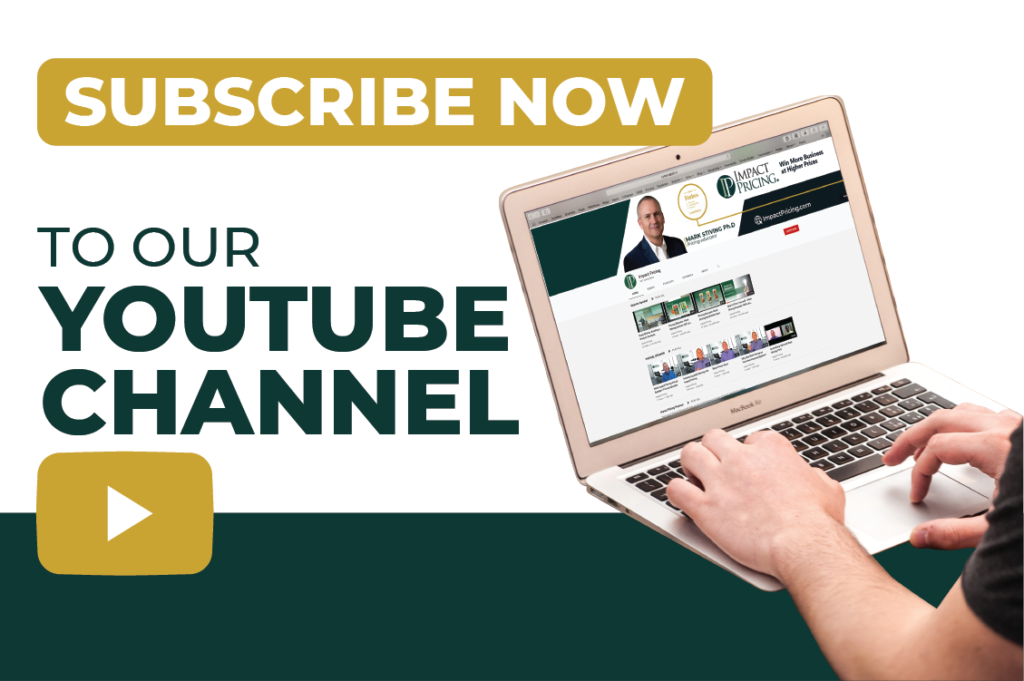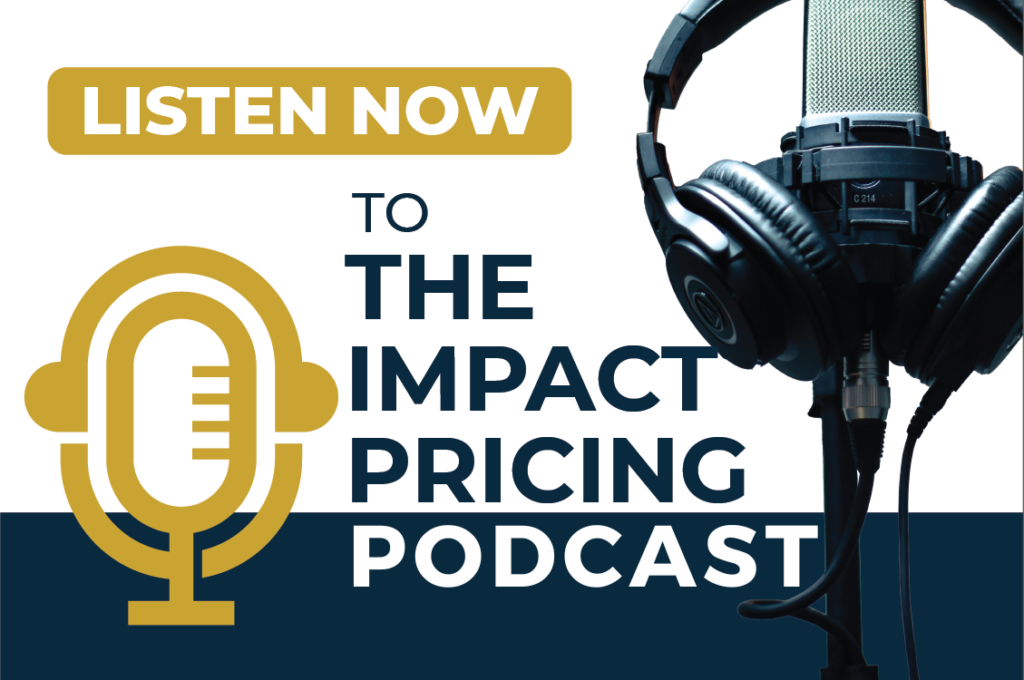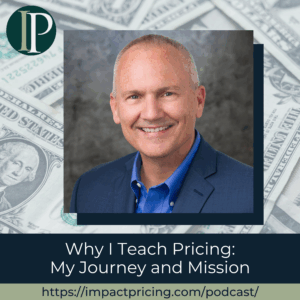Mark Peacock helps B2B Tech & Consulting firms expand margin & revenue growth with tailored pricing solutions & sales enablement.
In this episode, Mark shares practical strategies for implementing price increases effectively, including a two-stage communication process to manage customer expectations and reduce resistance. He emphasizes the importance of segmenting clients by price sensitivity and value to tailor pricing strategies and build confidence. Mark also highlighted the need to treat price increases for existing customers with the same care as new business pricing to maximize business impact.
Podcast: Play in new window | Download
Why you have to check out today’s podcast:
- Learn proven strategies to implement price changes confidently without losing customer trust or loyalty.
- Discover an innovative approach to preparing customers for price increases minimizing resistance, and maximizing acceptance.
- Explore techniques for segmenting clients, leveraging value-based pricing, and fostering long-term relationships.
“Treat price increases for existing customers with the same importance that you do pricing for new business, because it can have such a profound impact on your business and it’s nothing to be scared of.”
– Mark Peacock
Topics Covered:
01:48 – Describing his pricing journey
02:58 – The transformative power of smart pricing strategies
06:13 – Check out Mark’s article in LinkedIn, ‘Raise Prices Without Raising Eyebrows’
06:52 – The importance of putting as much effort into planning and communicating price increases with existing customers as devoting to winning new business
09:21 – The two-stage process to make price increase more acceptable to your customers
12:34 – The third step to communicating your price increase
14:49 – Explaining the value reasons why customers should stick with you [the fourth step]
16:55 – Communicate your ‘investment story’ [fifth step]
18:44 – Give your customers the options and do away with hard sell [sixth step]
21:53 – Talking about frictionless approach to price increase [seventh step]
23:22 – Important thoughts on the ‘do something nice’ strategy
26:45 – One top tip to help you segment customers based on price sensitivity and stop churn
27:59 – More techniques for customer segmentation
28:59 – Mark’s best pricing advice
Key Takeaways:
“Communicating a price increase is a sales task, and you would never use negative language in a sales activity.” – Mark Peacock
“The most important thing about a price increase communication is that there is no hard sell.” – Mark Peacock
“You need to provide them with some ways to come back to you however they want, either to approve it, to reject it, to discuss it, or if you’ve got upgrade or downgrade paths as well.“ – Mark Peacock
“Be as open and transparent as possible so that the buyer has total agency and control over that decision, and you are making it entirely their decision because that’s how you build trust.” – Mark Peacock
Connect with Mark Peacock:
Connect with Mark Stiving:
- LinkedIn: https://www.linkedin.com/in/stiving/
- Email: [email protected]
Full Interview Transcript
(Note: This transcript was created with an AI transcription service. Please forgive any transcription or grammatical errors. We probably sounded better in real life.)
Mark Peacock
Treat price increases for existing customers with the same importance that you do pricing for new business, because it can have such a profound impact on your business and it’s nothing to be scared of.
[Intro / Ad]
Mark Stiving
Welcome to Impact Pricing, the podcast where we discuss pricing, value, and the amazing relationship between them. I’m Mark Stiving and I run bootcamps that help companies get paid more. Our guest today is Mr. Mark Peacock. Here are three things you want to know about Mark before we start. He’s been running PriceMaker, a pricing consultancy now for over four years, so he’s actually made a business of it. Awesome. He was the director of pricing at a company called Kiss the Fish. Just love the name of that company. And he recently wrote an article called, How to Plan a Price Change Communication. And that’s what we’re going to talk about today. Welcome, Mark.
Mark Peacock
Hi, Mark. Great to be here. Thanks for the lovely introduction. It’s great to talk to you again.
Mark Stiving
It is always nice having you here. So, remind us, how’d you get into pricing in the first place?
Mark Peacock
So I had a 25-year career in corporate. I was in all sorts of roles, marketing, product management and running a business unit within a large corporation. And price always played a part in all of those various roles, especially when you are responsible for P&L. And when I left, I decided I wanted to work for myself, run my own consulting business, and I decided to focus on price because from my perspective at that time, very few people were talking about it especially in the small to medium sized business end of the scale, which is kind of where I mostly worked. So that was it really. I had my little eureka moments. I read loads of books, including yours, and I thought, ‘Yeah, there’s a lot of value to be explored here. I’m going to plant my flag on the pricing mountain and see what happens.’ And here we are. Well, it’s been seven years now. Here we are, seven years later, I’m still going strong. So it obviously resonates with some people, clearly.
Mark Stiving
Yeah, clearly. And so you must have realized that pricing was really powerful for people. And yet so few people understand it and think about it.
Mark Peacock
It’s such a challenge, isn’t it? And it’s an ongoing battle, I think, from people like myself and you to help educate the business audience about the value and the power of pricing. Because we understand it, we understand it deeply, and we know what a small change to price can mean, both top line and bottom line. And in terms of the conversations that I have with businesses, so many of them still think, ‘Well, pricing isn’t that difficult, is it?’ We can work that out one afternoon in a management meeting and we’ll just ask the finance guy and the sales guy, and then I’m the boss, I’ll make the decision, and then off you go. But we know that there is so much more potential that can be created with smart pricing thinking whether it’s understanding, a willingness to pay and researching it whether it’s deploying psychological pricing techniques to help influence customer’s perception of price and also educating people to take away the fear that they have about making pricing decisions and things like communicating price changes and helping getting people past those fears because yeah, it’s such a powerful lever. But all too often I think people leave it to last in terms of what are the things that we can do to drive growth? And that’s the slight illustration, I think.
Mark Stiving
And what I find fascinating is the one thing that you didn’t mention, and to me it feels like it’s the biggest thing that I’ve come to realize most recently, and that is that once someone starts thinking about pricing, and you start thinking about a buyer’s willingness to pay, it starts to influence what products do you choose to build, right? How do you package the features that you have? What are the marketing messages you’re going to put out? How do you teach your salespeople to communicate value to your marketplace? And it isn’t really the pricing, but it’s the thinking about pricing that gets you to all those places.
Mark Peacock
Yeah, a hundred percent. And we know that, right? We know that price isn’t just a number or a sticker. It affects all of those things. And as you say, once you start to work on it, you realize that it impacts products, positioning, proposition, communication, P&L, so many things. And that’s what makes it fun for people like you and me. But I don’t think business leaders, generally speaking, do appreciate that. And it’s only once they’ve maybe read your book or been to a workshop or seen a webinar or something that a light bulb starts to go on above the head and they start to think, ‘Oh, okay, well maybe this is something that we should be doing more with.’ And that’s the kind of reaction I get once I’ve done a workshop for some business leaders and it’s, ‘Oh, okay, there’s a bit more to it than cost-plus-margin pricing, for example. ‘
Mark Stiving
Exactly. Okay. So my favorite thing about doing this podcast, by the way, is disagreeing with people. And it turned out I read your article on communicating price increases, and I loved it. It’s like, ‘Oh my gosh, there’s one little knit in there that I’m going to pick with you.’ You already know what it is. There’s one little knit that I’ll pick with you. But let’s talk about this. Because this is really good. First off, where can people get this if they want to read it?
Mark Peacock
So if they head to my LinkedIn profile which is mark-peacock-pricemaker. I think, a post that I’ve put out in the last week or so, on the 13th of January, they’ll find it, it’s called Raise Prices Without Raising Eyebrows. And if they just comment, yes, I’ll send it to them directly. So it is very easy to find me.
Mark Stiving
Yeah, great title and great cover photo, by the way.
Mark Peacock
Yeah, my designer found that for me. I was very pleased with it.
Mark Stiving
Yeah, that was really well done. Okay, so let’s just talk about it . First, step back. Why does it matter? Right? We’re going to raise prices anyway, so why does it matter how we tell people we’re going to raise praises?
Mark Peacock
It’s so important, isn’t it? So, one example I like to give is, imagine the amount of effort you put into winning new business, right? Whatever kind of business you are running, you put a huge amount of effort into creating a beautifully designed sales deck. You might have some explainer videos or fancy how-to guides. You prepare your initial pricing position, and hopefully your negotiating positions. You roll out the big guns and you send them along to the sales meeting, and you give it your best shot, don’t you? You put a huge amount of effort into winning new business. But when it comes to implementing price increases with existing customers, the amount of effort that gets put in is far, far lower. And at best, you’ll have a management team, they’ll decide on the most that they can charge without upsetting customers.
And it’s an across the ball price increase across all customers, all products, 5%. They give direction to the sales and marketing teams and say, ‘Right off you go.’ Somebody drafts a crappy little email and they send it off to their clients, and then they hope for the best. So the amount of effort that’s put into planning a price increase communication is far, far less than the amount of effort we put into winning new business. But as we know, it’s far easier to keep customers than win new business. And the profit uplift that you’ll get from properly implementing a price increase campaign is going to make a huge difference to your bottom line compared to looking at the top line growth that you win through new business. So comparing efforts on new business versus existing is an interesting thing to do. And then as we know getting the rewards from a properly implemented price increase are huge compared to your new business activities. So yeah, that’s my attitude on that.
Mark Stiving
Yeah. And what’s interesting is, you had mentioned really early on that one of the things that we think about a lot is the psychology of pricing. And so if you think about it, a price increase communication is really just manipulating, or that, what a horrible word, really just managing the psychology of our customers. That it isn’t really, it’s not going to change how much we raise prices. It is going to change their perspective of our price increase.
Mark Peacock
Exactly that. And I’d love to talk to you, Mark, about, I mentioned in the PDF that I sent out a two-stage communication process which is a really effective way of managing expectations with your customers. So if you’ll allow me to elaborate on that just quickly. So the idea is rather than just sending out a single communication and saying, ‘Dear customer, we’re putting out our prices next 1st of January by X,’ you do it in two stages. So, the first stage is, ‘Dear customer, we’re putting, or we’re writing to let you know that we’re going to be putting prices up. Here’s all of the reasons why we feel we need to do this. Here are all the benefits that you’ll still get from us. Here’s the investment that we’re making in the business to drive future benefits. Here are your options in case you’re not happy about it,’ but you don’t mention what the actual price change is.
And you say, ‘Will write and confirm that to you at the beginning of next month.’ So you break it down into two parts, you tell the customer it’s coming. And that has the benefit of flushing out people who are really, really nervous or anxious about this. But you don’t tell them exactly how much. And then you follow it up a month later and you say, following our last month’s communication, your prices from the 1st of January are X, but you’ve done all the hard work by then. You’ve set their expectations, they know something’s coming and then hopefully as long as you’ve done it properly, the actual price increase won’t be as much as maybe the figure that they’ve got in their heads. So, yeah, that kind of two-stage communication is a great way of influencing their expectations and their attitudes as to what’s coming.
Mark Stiving
Yeah, that’s really interesting. My dissertation advisor was an expert in reference prices, and so I’m going to talk about what you just said in an academic sense for just a brief moment. And what I just heard you say is that I’m going to tell them a price increase is coming and here’s why. And so what I’m really doing is adjusting their reference price. I’m making them assume that they’re going to end up paying a higher price. And so later, when I actually make them make the decision, are you going to stay or are you going to go, they’ve set a higher reference price, which means they’re much less likely to churn.
Mark Peacock
Exactly that, Mark. Exactly. So you’ll set an expectation without committing a number, and people tend to assume the worst, right? They think, ‘Oh, wow, these guys are going to put my prices up by 10, 20%, whatever.’ And then the actual communication comes through and it’s 5% or whatever the number is, and they go, ‘Oh, great, it’s fine. It’s not nearly as bad as I thought. Fabulous. Let’s crack on.’ So yeah, exactly that. It’s such a smart technique and I’ve done it with a manufacturing company, a tech company, and it really helps to smooth the path to an effective price increase outcome.
Mark Stiving
Nice. Love that. So, let’s talk about communication. When I teach this, I always give them, here’s the five things you want to say. I want to go through yours. And by the way, I think we agree pretty much completely on those. Okay. So, let’s start. What’s the first step?
Mark Peacock
Yeah, simply just introduce yourself. Let your customer know we’re writing to let you know of some plan changes to our prices for 2024 whenever it’s coming in, just to give some context. And then fairly early on you want to be saying this is because, and you are telling the customer that some of your costs have increased. And it could be your raw materials, it could be your labor costs, could be transportation, it could be your infrastructure costs or whatever, but you are giving them a reason that they can understand and accept and believe and you don’t need to go into too much detail, but you’re just giving them that early explanation as to why it needs to happen. So, that’s the opening gambit from my point of view, Mark.
Mark Stiving
Yep. I agree a hundred percent. I used to say, in fact, I still believe wholeheartedly that nobody wants to know that you want to make more money, right? But if your costs go up, then they kind of understand it, even though you and I both know costs don’t drive pricing. Our customers don’t know that, and their expectation is that if our costs go up, our prices should go up.
Mark Peacock
Yeah, exactly that. So it’s an important aspect of the price communication story, I think, but we mustn’t labor it and overdo it. One of the pieces of advice I give about the language that’s used in these communications is always to keep it neutral or positive and to avoid any negative language. So we shouldn’t be saying things like, unfortunately, our costs have gone up. We apologize for the price increase. Remove all of those negative words and replace them with neutral or positive only language. And it’s not too difficult because what you are actually doing is, this is a sales task. Communicating a price increase is a sales task, and you would never use negative language in a sales activity, would you? So neutral, positive language only, please.
Mark Stiving
Nice. So step three, by the way, we just hit steps one and two. Step three was the one versus two-stage, and we talked about the two-stage process already. Yep. That was awesome. Hit me with step four.
Mark Peacock
Okay. So now the hard work begins. So we’ve told them what’s happening, we’ve told them when it’s coming and we’ve said why it’s happening, but now we need to explain the reasons, the value reasons why they should continue to believe that we offer the best product, the best service for them. So, this is where we start to roll out some evidence of the value that you’ve created for the client, which could be, we’ve increased your number of marketing leads that you’ve generated over the last year by 10% or whatever is the key thing that your company does. A reminder of your key differentiators, what makes you different to everybody else. And just a reminder again about what makes you the best at what you do. So you are selling hard, right, on the key benefits and reasons why they chose to work with you in the first place, because people tend to forget these things. So we need to constantly remind them. So this is the place to do it because we need to justify the price that we’re charging.
Mark Stiving
Okay? So let me give two, I’m going to give two additions to this, if I may. One is I often talk about something called proven value. And so proven value is did you get before and after data? So do you know how many marketing leads they had before they put your product in, and how many marketing leads they had after? So now we’ve got this data that says,’ Hey, look what we’ve done for you.’ Right? This is really valuable. And so that’s certainly a huge advantage to us which is what you just said, by the way.
Mark Peacock
You explained it better than I did.
Mark Stiving
And then the second add-on I’d like to give is, at this point, I often like to say, here’s what we’ve put in the product since you signed up last year, right? Or for whatever it is. And so here’s how we’ve made enhancements to what it is that you have. Yeah. And so what I love about number four is it really talks about the past, but when we get to number five, it talks about the future. So, let’s hear your number five.
Mark Peacock
So, number five is what I call your investment story. So what are you doing to invest in your business in a way that’s meaningful for your clients? What improvements are you making for the future that they can expect to look forward to and receive the benefits of? So it could be your developing new features to add to your product. It could be you are investing in new systems that will make your product or your service faster. New digital capability, new systems. It could be you are recruiting more people to handle more calls. It could be you’re expanding your geographic footprint to cover more regions or whatever it is. Everybody, every business should have a plan for investment and growth. So let’s talk about these things and let’s remind them that you are constantly seeking to improve the value that you offer them so that they’re not just judging the current price increase that you’re asking for. They’re doing it as well,thinking , ‘Okay, well, I’ve got to pay an extra 10%, but I can see that there’s these other things coming down the track as well. So that’s good news for me, hopefully as a buyer. And that means I’m more likely to want to stick with it.’ So that’s what I mean by your investment story, Mark.
Mark Stiving
Yeah, I love that. Like me, I know that you watch, specifically, price increase communications, especially when they affect you personally. Yeah. So, I remember a year or two ago getting one from Netflix, and one of the points that Netflix made was, we want to continue to invest in original content for you. Right? It’s like, yep, let’s talk about the investment strategy. What are we going to do with this? Yeah. And let’s talk about number six then. What are we going to do next?
Mark Peacock
Okay. So I think the most important thing about a price increase communication is that there is no hard sell, right? So we don’t ever want somebody on the receiving end of this approach to feel that they’ve got no options. That they’re being forced into this price increase. So we have to present options to them and what they can do as a result of receiving this information. So number six is called options. So what options can clients typically take? They can say, ‘No, I don’t like this, and cancel the contract entirely.’ They could say, ‘No, I don’t like this,’ and they might want to negotiate with you. They might say, ‘Well, we need to discuss it internally, or they might say, yeah, that’s fine. We accept it.’ All night, just do nothing and it just rolls through without anybody noticing.
So you need to provide them with some ways to come back to you however they want either to approve it, to reject it, to discuss it, or if you’ve got upgrade or downgrade paths as well, to offer those as well. Be as open and transparent as possible so that the buyer has total agency and control over that decision, and you are making it entirely their decision. There’s no sense of pressure or hard selling or anything like that because that’s how you build trust, right? And the better examples of this, I’ve given a longer notice period at least two months the longer the notice period you can give that shows confidence, right? So, giving well-rehearsed, well thought out options is that next section Mark. What are your thoughts on that?
Mark Stiving
So, I got a couple thoughts. First off, the ‘do nothing’ I agree with a hundred percent and make it easy to cancel if you don’t want to continue, agree with a hundred percent, right? I mean, I think those are great. Yeah. I don’t think I would ever mention, call us if you have a problem with this or let us know if you want to negotiate a lower price. It is like, no, no, no, no, no. If you want to lower the price, you’re going to pick up the phone and call me and complain, and then I’ll have a strategy for what it is I want to do about that inside. The other one that I love is what a great opportunity to upgrade customers, right? So if I could upgrade you to the old best price Right? When I think about good, better, best, right? So, I have a best price and I’m raising the best price too, but if I could upgrade you from your current better price to the old best price while I’m giving you a price increase for better, it’s like, ‘Oh, now it’s a much smaller jump,’ and by the way, next year you’ll get hit with the best price increase. So that’s okay.
Mark Peacock
Yeah, great tactic. And I think that’s where the benefit of having pre-thought out your responses in terms of options, packages, plans, upgrades, or even an negotiation. That’s where that comes in so well. So yeah. Love it. Great one.
Mark Stiving
Yeah. I think that’s spot on. Number seven, next step.
Mark Peacock
Oh yeah, next steps. So just to be clear about what’s going to happen. So, for example, a frictionless approach to price increases is to not require anybody to do anything, if they’re happy to accept it, right? So you don’t want people to tell you that’s, yes, that’s fine, we accept it, just carry on as it were. And then the bill from the next month or the next year just kicks in automatically. So you want as frictionless a process as possible from your point of view, but then you need to be clear about the timelines, you need to be clear about contract terms, if there’s a notice period and so on. So you just need to be clear on what people need to do and by when and if they don’t need to do anything, that’s great.
Mark Stiving
Nice. So ,one of the things I add to that I often talk about, if it’s possible, and it’s not always possible, and I call it the ‘do something nice’ strategy. And so the ‘do something nice’ part is by the way, I learned this one from Netflix. So, the very first Netflix price increase was horrendous and they lost what I know this 300,000 subscribers or something, some ridiculous number. And then their second price increase, which they did two years later, was perfect. And one of the things they did was they said, ‘Hey, you’ve been a loyal customer, we really appreciate it. We’re raising prices on January 1st, but we’re going to hold your price constant until March 1st, or July 1st or something like that.’ I call it the ‘do something nice’ strategy.
Mark Peacock
Yeah. Perfect. So, we can upgrade you without increasing your prices for two extra months, or we can give you access to extra features or whatever it is. Yeah. or we can extend the current price for 90 days. Yeah. Whatever. So yeah. Great. Add to everything. I might add that to my guide actually, because that’s a smart move.
Mark Stiving
Feel free. So Netflix came up with that, not me.
Mark Peacock
Okay, fine.
Mark Stiving
Alright. So, why don’t people raise prices enough? Why don’t companies raise prices?
Mark Peacock
Well, the obvious answer is fear, fear of upsetting customers, right? We don’t want to have that awkward conversation with our key clients where we have to have it speak to them personally and say, ‘Oh, sorry, Mark, your prices are going up by XY percent next year.’ And we don’t know how to handle that. So, stops us taking action and we resort to lowest common denominator actions, which are, let’s just put everybody’s prices up by 3%, whatever the number is, rather than taking a more considered approach, which is, if you have a client-based business, you should literally go through your entire client portfolio and work out a plan for every single one of them or a product-based business, then you do it at a product level rather than across the board. The beauty of doing that is by taking that more granular approach, you do come to understand what is possible more clearly, and you’ll put in place a better plan so that will help you get past that fear of taking action.
I’ve also seen it where I worked with a client, they were a global exhibitions company and they had an amazing product. They run a global exhibition in print and digital technology every year in Germany. And it was a huge money earner for them, but their board was highly aggressive about their price increases. And they gave this big talk to the business team, saying, ‘You’ve got to increase your prices by 10%.’ And the business team and the sales team were terrified by this. So they tried to do it as best they could, and they were scarred by all of the horrendous feedback they got from their clients. So every year thereafter, they did nothing or the least that they could get away with. So I think previous experiences play into that as well, that awkward encounter where you’ve got an angry customer on the phone demanding to know why you have the temerity to put your prices up like this. But if you put in place a plan as we suggested along the lines of what we’ve just talked about that can give you the confidence that you need then to be able to go to market or to equip your teams with the tools and the techniques they need to communicate a price change. And more often than not, it’s never as bad as you think. Is it?
Mark Stiving
Never, I love the fact that you focused on confidence there. Because one of the things that makes a lot of sense when you’re doing price increases or you’re afraid to do a price increase, is pick a subset, right? Take a subset of your customers or a subset of your products and say, ‘Let’s go do this.’ And by the way, you could choose the ones you think are most likely to accept the price increase and, and start to watch that it’s not as painful as you think it is. Yeah. And you’re just putting free money in your pocket.
Mark Peacock
Yeah. A really simple technique is, say if you have a client based business and you have a hundred clients, get an Excel sheet of all of those clients, their previous 12 months spend or revenue if you know it, what the gross profit margin is per client, but some businesses don’t know that how long they’ve been trading with you, what their lifetime value is, et cetera. So you’ve almost got like half a dozen columns of data for each client. And then just put another column headed price sensitivity and rate each one of them high, medium or low in terms of price sensitivity. And this is just your judgment based on your knowledge and experience of working with them. And then you’ll find a proportion of them will be highly sensitive to a price increase somewhere in the middle, and some you’ll believe will have low price sensitivity. So start with those guys. And that’ll give you a huge amount of confidence and you could possibly be a bit more ambitious with your price changes for those with low price sensitivity, and then move up the scale once you’ve built up that experience and that knowledge of how people are reacting. So, that’s a really simple way just to think about segmenting your customer base by your judgment on their price sensitivity.
Mark Stiving
Yep. I love that. And then I’ll add one more to that, and that is, can you determine which ones get the most value from you? So you might say, which ones interact the most often or which ones we’ve, we can tell how much profit we’ve put in their pocket for whatever reason. Yeah. And start with the ones with the most value because they’re not going to leave you.
Mark Peacock
Yep. Great. So, how many, the number of features they use, the adoption rate on your platforms just, just feedback on how much they love you as a supplier, strength of relationships, all of these things can play a part in helping you make a decision on that, but you need to do it client by client. And it doesn’t take that long. It’s not a painful exercise unless you’ve got thousands of clients, but if you’ve got even hundreds of clients, it’s perfectly possible to do it and it makes a big difference. Yeah.
Mark Stiving
Hey, Mark, this has been a ton of fun. I’m going to ask the final question though. What is the one piece of pricing advice you’d give our listeners that you think could have a big impact on their business?
Mark Peacock
So, I would say, treat price increases for existing customers with the same importance that you do in pricing for new business, because it can have such a profound impact on your business and it’s nothing to be scared of.
Mark Stiving
Absolutely, right. Mark, thank you so much for your time today. If anybody wants to contact you, how can they do that?
Mark Peacock
Best place is to find me on LinkedIn. My profile is called MarkPeacock-PriceMaker. If you can find me, get in touch, and I’ll do what I can to help.
Mark Stiving
Excellent. Thank you. And to our listeners, thank you for your time. If you enjoyed this, would you please leave us a rating and a review? And finally, if you have any questions or comments about the podcast or if your company wants help getting paid more for the value that you deliver, feel free to email me, [email protected]. Now, go make an impact!
[Ad / Outro]
















